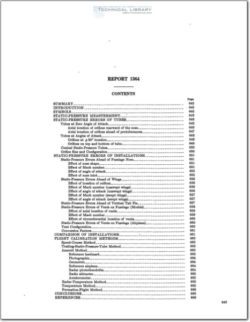NACA-Report-1364

- Version
- 204 Downloads
- 2.60 MB File Size
- 1 File Count
- December 4, 2015 Create Date
- December 4, 2015 Last Updated
National Advisory Committee for Aeronautics, Report - Measurement of Static Pressure on Aircraft

Episting data on the errors involved in the measurement of
static pressure by means of static-pressure tubes and fuselage
vents are presented. The errors associated with the various de-
sign features of static-pressure tubes are discussed for the condi-
tion of zero angle of attach: and for the case where the tube is in-
clined to the flow. Errors which result from variations in the
configuration of static-pressure vents are also presented. Errors
due to the position of a static-pressure tube in the flow field of
the airplane are given for locations ahead of the fuselage nose,
ahead of the wing tip, and ahead of the vertical tail fin. The
errors of static-pressure vents on the fuselage of an airplane are
also presented.
A comparison of the calibrations of the four static-pressure-
measuring installations indicates that, for an airplane designed
to operate at supersonic speeds, a static-pressure tube located
ahead of the fuselage nose will, in general, be the most desirable
installation. If the operating range is confined to speeds below
sonic, a static-pressure tube located ahead of the wing tip may,
for some airplane configurations, prove more satisfactory than a
fuselage-nose installation. For operation at Mach numbers
below 0.8, a static-pressure tube ahead of the vertical tail fin'or
fuselage vents, properly located and installed, should prove
satisfactory.
Various methods of calibrating static-pressure installations in
flight are briefly discussed.
The proper functioning of fire-control and guidance sys—
tems for airplanes and missiles depends fundamentally on the
accurate measurement of total and static pressures. For
each of these measurements the basic problem is that of de-
termining what type of sensing device to use and where to
locate it on the flight vehicle.
The National Advisory Committee for Aeronautics has
been studying this problem for many years. A comprehen—
sive survey of the subject, based on information obtained at
subsonic speeds, was published in 1948 (ref. 1). Since that
time additional data have been obtained fi'om Wind tunnel,
rocket-model, and flight tests in the transonic and low super—
sonic speed ranges. Because of current interest in this in-
formation, it appeared appropriate at this time to present
these data and to review the overall problem in the light of
this new knowledge.
| File | Action |
|---|---|
| naca-report-1364.pdf | Download |

Comment On This Post